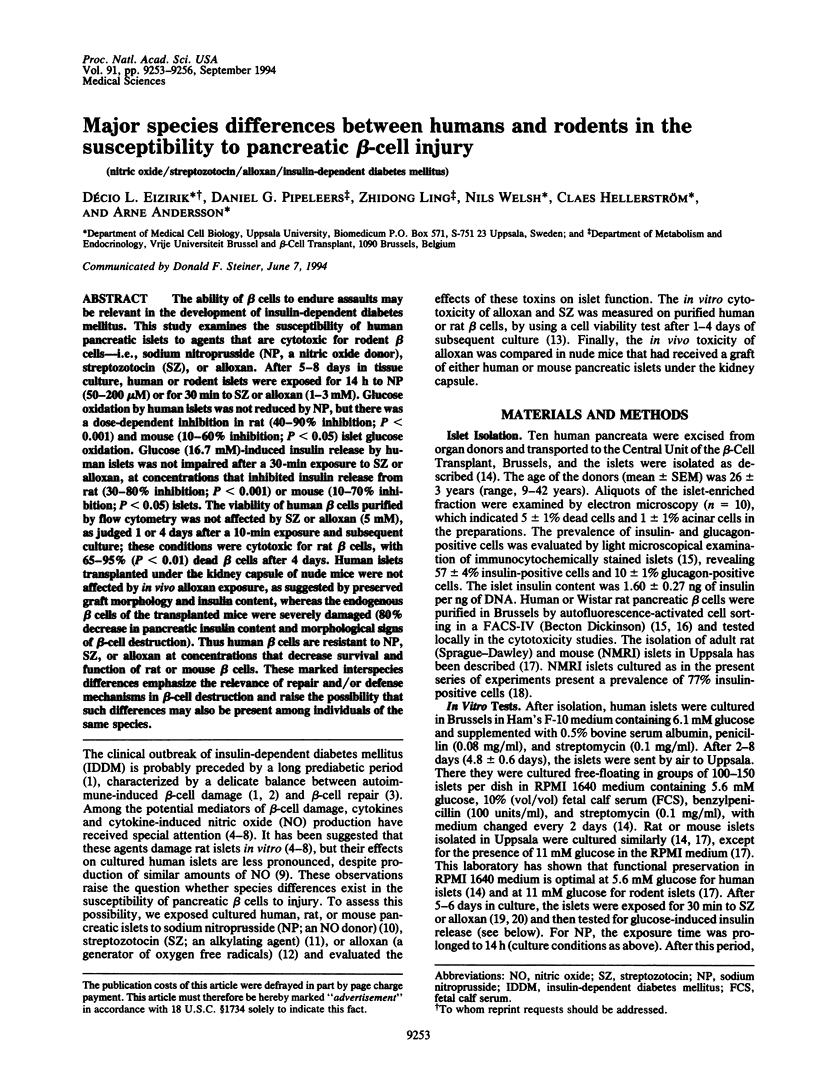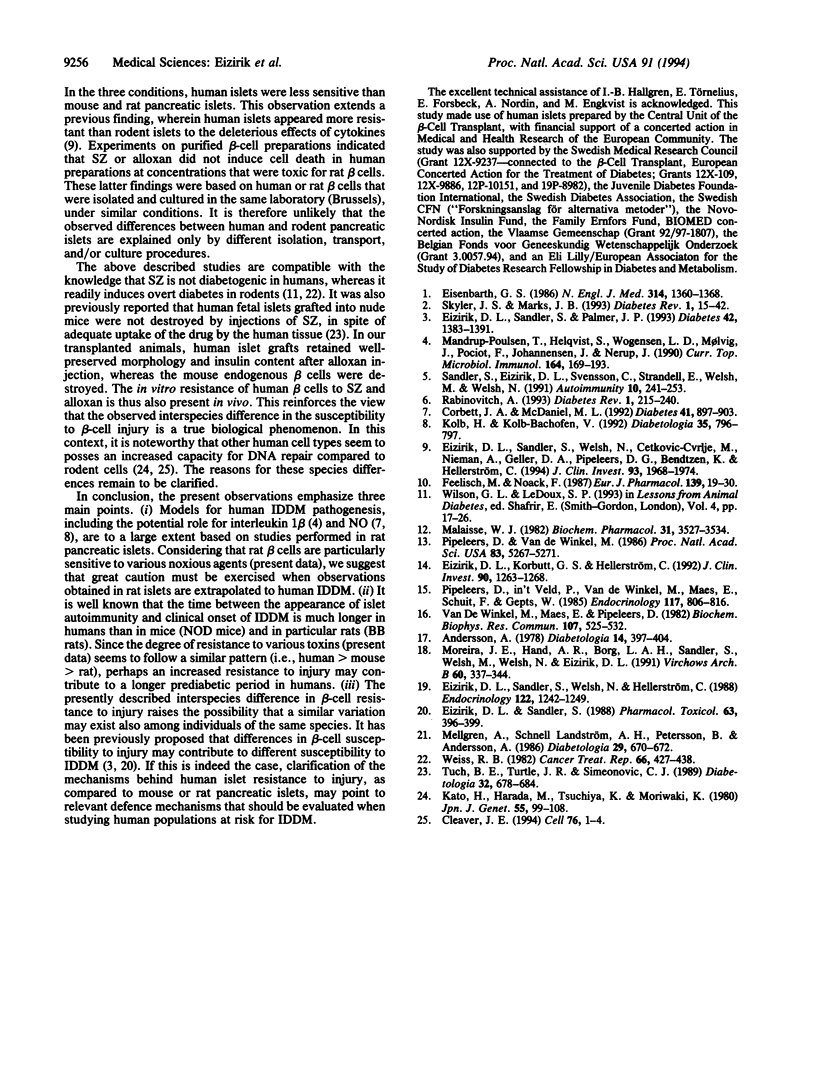Abstract
The ability of beta cells to endure assaults may be relevant in the development of insulin-dependent diabetes mellitus. This study examines the susceptibility of human pancreatic islets to agents that are cytotoxic for rodent beta cells--i.e., sodium nitroprusside (NP, a nitric oxide donor), streptozotocin (SZ), or alloxan. After 5-8 days in tissue culture, human or rodent islets were exposed for 14 h to NP (50-200 microM) or for 30 min to SZ or alloxan (1-3 mM). Glucose oxidation by human islets was not reduced by NP, but there was a dose-dependent inhibition in rat (40-90% inhibition; P < 0.001) and mouse (10-60% inhibition; P < 0.05) islet glucose oxidation. Glucose (16.7 mM)-induced insulin release by human islets was not impaired after a 30-min exposure to SZ or alloxan, at concentrations that inhibited insulin release from rat (30-80% inhibition; P < 0.001) or mouse (10-70% inhibition; P < 0.05) islets. The viability of human beta cells purified by flow cytometry was not affected by SZ or alloxan (5 mM), as judged 1 or 4 days after a 10-min exposure and subsequent culture; these conditions were cytotoxic for rat beta cells, with 65-95% (P < 0.01) dead beta cells after 4 days. Human islets transplanted under the kidney capsule of nude mice were not affected by in vivo alloxan exposure, as suggested by preserved graft morphology and insulin content, whereas the endogenous beta cells of the transplanted mice were severely damage (80% decrease in pancreatic insulin content and morphological signs of beta-cell destruction). Thus human beta cells are resistant to NP, SZ, or alloxan at concentrations that decrease survival and function of rat or mouse beta cells. These marked interspecies differences emphasize the relevance of repair and/or defense mechanisms in beta-cell destruction and raise the possibility that such differences may also be present among individuals of the same species.
Full text
PDF



Selected References
These references are in PubMed. This may not be the complete list of references from this article.
- Andersson A. Isolated mouse pancreatic islets in culture: effects of serum and different culture media on the insulin production of the islets. Diabetologia. 1978 Jun;14(6):397–404. doi: 10.1007/BF01228134. [DOI] [PubMed] [Google Scholar]
- Cleaver J. E. It was a very good year for DNA repair. Cell. 1994 Jan 14;76(1):1–4. doi: 10.1016/0092-8674(94)90165-1. [DOI] [PubMed] [Google Scholar]
- Corbett J. A., McDaniel M. L. Does nitric oxide mediate autoimmune destruction of beta-cells? Possible therapeutic interventions in IDDM. Diabetes. 1992 Aug;41(8):897–903. doi: 10.2337/diab.41.8.897. [DOI] [PubMed] [Google Scholar]
- Eisenbarth G. S. Type I diabetes mellitus. A chronic autoimmune disease. N Engl J Med. 1986 May 22;314(21):1360–1368. doi: 10.1056/NEJM198605223142106. [DOI] [PubMed] [Google Scholar]
- Eizirik D. L., Korbutt G. S., Hellerström C. Prolonged exposure of human pancreatic islets to high glucose concentrations in vitro impairs the beta-cell function. J Clin Invest. 1992 Oct;90(4):1263–1268. doi: 10.1172/JCI115989. [DOI] [PMC free article] [PubMed] [Google Scholar]
- Eizirik D. L., Sandler S. Functional restoration of cultured mouse pancreatic islets after in vitro exposure to alloxan. Pharmacol Toxicol. 1988 Nov;63(5):396–399. doi: 10.1111/j.1600-0773.1988.tb00975.x. [DOI] [PubMed] [Google Scholar]
- Eizirik D. L., Sandler S., Palmer J. P. Repair of pancreatic beta-cells. A relevant phenomenon in early IDDM? Diabetes. 1993 Oct;42(10):1383–1391. doi: 10.2337/diab.42.10.1383. [DOI] [PubMed] [Google Scholar]
- Eizirik D. L., Sandler S., Welsh N., Cetkovic-Cvrlje M., Nieman A., Geller D. A., Pipeleers D. G., Bendtzen K., Hellerström C. Cytokines suppress human islet function irrespective of their effects on nitric oxide generation. J Clin Invest. 1994 May;93(5):1968–1974. doi: 10.1172/JCI117188. [DOI] [PMC free article] [PubMed] [Google Scholar]
- Eizirik D. L., Sandler S., Welsh N., Hellerström C. Preferential reduction of insulin production in mouse pancreatic islets maintained in culture after streptozotocin exposure. Endocrinology. 1988 Apr;122(4):1242–1249. doi: 10.1210/endo-122-4-1242. [DOI] [PubMed] [Google Scholar]
- Feelisch M., Noack E. A. Correlation between nitric oxide formation during degradation of organic nitrates and activation of guanylate cyclase. Eur J Pharmacol. 1987 Jul 2;139(1):19–30. doi: 10.1016/0014-2999(87)90493-6. [DOI] [PubMed] [Google Scholar]
- Kolb H., Kolb-Bachofen V. Type 1 (insulin-dependent) diabetes mellitus and nitric oxide. Diabetologia. 1992 Aug;35(8):796–797. doi: 10.1007/BF00429103. [DOI] [PubMed] [Google Scholar]
- Malaisse W. J. Alloxan toxicity to the pancreatic B-cell. A new hypothesis. Biochem Pharmacol. 1982 Nov 15;31(22):3527–3534. doi: 10.1016/0006-2952(82)90571-8. [DOI] [PubMed] [Google Scholar]
- Mandrup-Poulsen T., Helqvist S., Wogensen L. D., Mølvig J., Pociot F., Johannesen J., Nerup J. Cytokine and free radicals as effector molecules in the destruction of pancreatic beta cells. Curr Top Microbiol Immunol. 1990;164:169–193. doi: 10.1007/978-3-642-75741-9_9. [DOI] [PubMed] [Google Scholar]
- Mellgren A., Schnell Landström A. H., Petersson B., Andersson A. The renal subcapsular site offers better growth conditions for transplanted mouse pancreatic islet cells than the liver or spleen. Diabetologia. 1986 Sep;29(9):670–672. doi: 10.1007/BF00869269. [DOI] [PubMed] [Google Scholar]
- Moreira J. E., Hand A. R., Håkan Borg L. A., Sandler S., Welsh M., Welsh N., Eizirik D. L. Decrease in insulin-containing secretory granules and mitochondrial gene expression in mouse pancreatic islets maintained in culture following streptozotocin exposure. Virchows Arch B Cell Pathol Incl Mol Pathol. 1991;60(5):337–344. doi: 10.1007/BF02899565. [DOI] [PubMed] [Google Scholar]
- Pipeleers D. G., in't Veld P. A., Van de Winkel M., Maes E., Schuit F. C., Gepts W. A new in vitro model for the study of pancreatic A and B cells. Endocrinology. 1985 Sep;117(3):806–816. doi: 10.1210/endo-117-3-806. [DOI] [PubMed] [Google Scholar]
- Pipeleers D., Van de Winkel M. Pancreatic B cells possess defense mechanisms against cell-specific toxicity. Proc Natl Acad Sci U S A. 1986 Jul;83(14):5267–5271. doi: 10.1073/pnas.83.14.5267. [DOI] [PMC free article] [PubMed] [Google Scholar]
- Sandler S., Eizirik D. L., Svensson C., Strandell E., Welsh M., Welsh N. Biochemical and molecular actions of interleukin-1 on pancreatic beta-cells. Autoimmunity. 1991;10(3):241–253. doi: 10.3109/08916939109001895. [DOI] [PubMed] [Google Scholar]
- Tuch B. E., Turtle J. R., Simeonovic C. J. Streptozotocin is not toxic to the human fetal B cell. Diabetologia. 1989 Sep;32(9):678–684. doi: 10.1007/BF00274256. [DOI] [PubMed] [Google Scholar]
- Van de Winkle M., Maes E., Pipeleers D. Islet cell analysis and purification by light scatter and autofluorescence. Biochem Biophys Res Commun. 1982 Jul 30;107(2):525–532. doi: 10.1016/0006-291x(82)91523-6. [DOI] [PubMed] [Google Scholar]
- Weiss R. B. Streptozocin: a review of its pharmacology, efficacy, and toxicity. Cancer Treat Rep. 1982 Mar;66(3):427–438. [PubMed] [Google Scholar]


